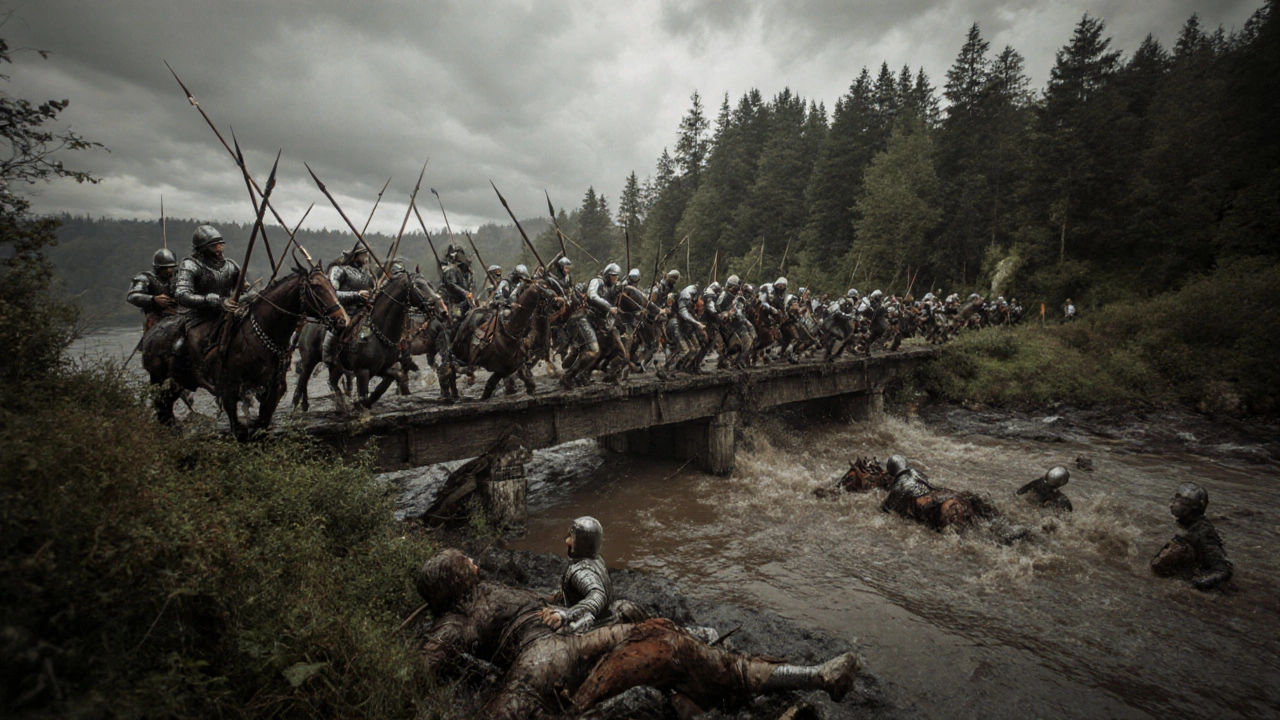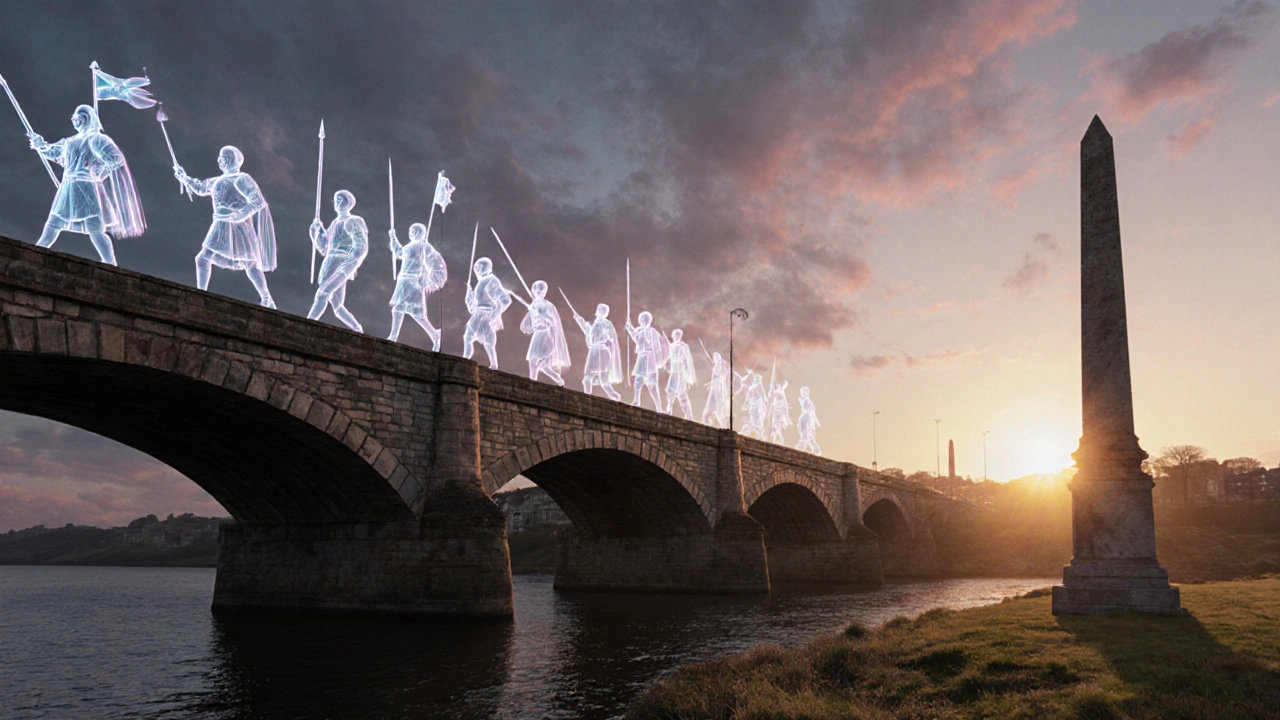
On September 11, 1297, a muddy field near Stirling became the turning point in Scotland’s fight for freedom. A ragtag army of Scottish peasants and lowland knights, led by a man with no noble title, crushed a well-equipped English force twice their size. This wasn’t a skirmish. It was the first real win Scotland had against England in generations-and it changed everything.
What Led to the Battle of Stirling Bridge
By 1296, Scotland was in ruins. King John Balliol had been forced to abdicate after losing the Battle of Dunbar. Edward I of England, known as "Longshanks," declared himself overlord of Scotland. He removed the Stone of Destiny, stripped Scottish nobles of power, and installed English sheriffs to rule the land. Taxes were raised. Land was seized. Resistance was crushed.
But not everyone bowed. In the countryside, men began to organize. William Wallace, a lesser-known knight from Elderslie, emerged as a leader. He wasn’t born into power. He didn’t have a castle or a royal bloodline. But he had something more dangerous: the trust of ordinary people. By early 1297, Wallace and Andrew de Moray had united forces from the north and south, gathering thousands of men armed with spears, axes, and sheer determination.
The English response came fast. John de Warenne, Earl of Surrey, led a professional army of 9,000 soldiers-cavalry, archers, and heavily armored knights. They marched toward Stirling, where the River Forth narrowed at a wooden bridge. Control of that bridge meant control of Scotland.
The Bridge That Changed a Nation
Stirling Bridge in 1297 wasn’t the stone structure you see today. It was a narrow, single-span wooden bridge, barely wide enough for two horsemen to ride side by side. It crossed a deep, fast-flowing river with steep, muddy banks. For the English, it was a natural choke point. For the Scots, it was a trap waiting to be sprung.
Wallace didn’t wait for the whole English army to cross. He held his men back, hidden in the woods on the north side. As the first wave of English cavalry and infantry moved across the bridge, Wallace let them get halfway. Then he gave the signal.
Scottish spearmen surged forward, cutting off the rear of the English column. The bridge, already crowded, became a death trap. Horses panicked. Men stumbled into the river. Armor, meant to protect, became a weight that dragged soldiers under. The English couldn’t turn around. They couldn’t retreat. And they couldn’t bring reinforcements across the narrow span.
By mid-afternoon, the English army was broken. Estimates suggest 5,000 English soldiers died-most of them drowned, crushed, or cut down on the bridge and the banks. The Earl of Surrey fled, leaving behind his baggage train, banners, and even his personal seal.
Why This Victory Mattered
This wasn’t just a military win. It was psychological. For the first time, Scotland had proven that the English army could be beaten-not by kings or treaties, but by ordinary men who refused to be ruled. Wallace became a symbol. His name spread from the Highlands to the Lowlands. Peasants who had spent years hiding now stepped forward to join the cause.
Edward I didn’t take the loss lightly. He spent the next year preparing a massive invasion. But Wallace’s victory gave Scotland breathing room. It gave the Scots time to organize. It gave them proof that resistance was possible.
By early 1298, Wallace was named Guardian of Scotland. He wasn’t king. He didn’t claim the throne. But he held the country together. For a brief moment, Scotland was free-not because of a treaty, but because of a bridge, a plan, and a man who refused to kneel.

What Happened After
The victory at Stirling Bridge didn’t end the war. Edward I returned in 1298 with a larger army, better tactics, and more archers. At the Battle of Falkirk, Wallace’s spearmen were overwhelmed by English longbows. He stepped down as Guardian soon after.
But the spark had been lit. Wallace was captured in 1305, tried for treason, and executed in London. His body was quartered. His head was placed on London Bridge. Yet his legacy lived on. Five years after his death, Robert the Bruce won the Battle of Bannockburn-and Scotland’s independence was secured.
Wallace didn’t live to see it. But without Stirling Bridge, there would have been no Bannockburn. No Declaration of Arbroath. No Scotland as a free nation.
Visiting the Site Today
The original wooden bridge is long gone. Today, a modern stone bridge carries traffic over the River Forth. But just upstream, near the village of Stirling, you’ll find the Battle of Stirling Bridge memorial. A stone obelisk stands where Wallace likely commanded his troops. A visitor center tells the story with maps, weapons, and firsthand accounts.
Walk down to the riverbank. Look at the narrow crossing. Imagine the mud, the noise, the fear. Now picture thousands of men charging across it-not for glory, but for freedom. That’s the real power of this place.

Common Myths About the Battle
Many people think Wallace wore face paint and fought in a kilt, like in the movie Braveheart. That’s fiction. Kilts didn’t become common until centuries later. Wallace likely wore a tunic and chainmail, like other knights of the time.
Another myth: Wallace was a peasant. He wasn’t. He came from a minor noble family. His father was a knight. That gave him the training and connections to lead. But he didn’t act like a lord. He fought beside his men. That’s what made him different.
And no, the bridge didn’t collapse under the weight of the English. It didn’t need to. The Scots cut off their retreat. The river and the narrow crossing did the rest.
Why This Battle Still Resonates
Stirling Bridge wasn’t the biggest battle. It wasn’t the bloodiest. But it was the first time a small, determined force used terrain, timing, and unity to defeat a giant. It’s a lesson in strategy, not just history.
Today, Scottish schoolchildren learn about it. Tourists from around the world come to see the site. Politicians quote Wallace’s words: "I would rather die than live in shame."
The battle reminds us that power doesn’t always lie in numbers. Sometimes, it lies in courage, in knowing when to strike, and in refusing to accept the world as it’s given to you.
Who won the Battle of Stirling Bridge in 1297?
The Scottish forces, led by William Wallace and Andrew de Moray, won the Battle of Stirling Bridge in 1297. They defeated a much larger English army under the Earl of Surrey by using the narrow bridge to trap and isolate the advancing troops.
Why was the Battle of Stirling Bridge important?
It was Scotland’s first major victory against English rule and proved that a smaller, well-led force could defeat a professional army. The win boosted Scottish morale, led to Wallace being named Guardian of Scotland, and inspired future rebellions that eventually secured independence.
How did William Wallace win at Stirling Bridge?
Wallace waited until half the English army had crossed the narrow wooden bridge, then attacked. He cut off their retreat and trapped them between the river and the Scots. The English cavalry couldn’t maneuver, their armor weighed them down, and many drowned in the river. The narrow crossing turned their strength into a weakness.
Did William Wallace wear a kilt at the Battle of Stirling Bridge?
No. Kilts as we know them today didn’t exist in 1297. Wallace likely wore a long tunic, leather armor, and chainmail, typical for a knight of his status. The kilt image comes from 19th-century romanticized art and the movie Braveheart.
What happened to William Wallace after the battle?
After Stirling Bridge, Wallace became Guardian of Scotland and led resistance for a year. He lost at Falkirk in 1298 and stepped down. He was captured in 1305, tried for treason in London, and executed by hanging, drawing, and quartering. His body parts were displayed across England as a warning.
Comments (11)
-
Mark Brantner November 20, 2025so like... wallace just waited for them to cross and then went full ninja on their asses? that's the dumbest most brilliant thing i've ever heard
-
Kate Tran November 21, 2025i love how this story doesn't rely on kings or magic or divine right... just a bridge, some spears, and a whole lot of guts. also the fact that they didn't even have kilts?? wow. so much better than braveheart.
-
amber hopman November 22, 2025i mean, the real hero here is the terrain. it’s not about how many men you have, it’s about how you use the ground. this is like the original guerrilla tactic. genius. also, wallace wasn’t even nobility?? that’s the whole point.
-
Jim Sonntag November 23, 2025braveheart ruined everything. now everyone thinks scots fought in kilts and painted their faces. the truth is way cooler. just a bunch of guys with spears and a plan. no dragons. no blue paint. just mud and math.
-
chioma okwara November 23, 2025actually the english lost because they were incompetent not because wallace was smart. the bridge didn't collapse, it was just poorly managed. also the word is "quartering" not "quatering". fix your spelling.
-
Tamil selvan November 24, 2025The bravery displayed by the Scottish forces at Stirling Bridge is truly commendable; the tactical discipline, the unity of purpose, and the refusal to submit-even in the face of overwhelming odds-reflects a profound moral courage. One cannot help but admire the strategic patience exhibited by Wallace, who understood that timing, not brute force, was the decisive factor. The psychological impact of this victory cannot be overstated, as it rekindled a national identity that had been systematically eroded. It is a reminder that leadership is not conferred by title, but earned through action.
-
Samar Omar November 25, 2025Honestly, the entire narrative around Wallace is so... reductive. We're talking about a moment that redefined sovereignty, yet it's reduced to a YouTube video with bad CGI and a soundtrack by James Horner. The real tragedy isn't the battle-it's that we've turned a profound political awakening into a Hollywood merchandising opportunity. The Stone of Destiny was stolen. The nobility were humiliated. And now we're all just here to argue about kilts. I'm not even mad. I'm just... disappointed.
-
Deepak Sungra November 26, 2025yo i just watched braveheart again last night and i swear wallace was the ultimate flex. no money no title just pure vibe. and the bridge?? that's not a battle that's a cinematic moment bro. imagine being one of those english knights trying to turn around on that thing. absolute nightmare. also why is no one talking about how he got his head on a spike?? that's next level loyalty. i would die for that kind of legacy.
-
Tasha Hernandez November 27, 2025Okay but let’s be real-Wallace was basically a glorified terrorist. He didn’t win because he was noble, he won because he ambushed people on a bridge. And then he got his guts dragged out for it. Honestly, the whole thing feels like a revenge fantasy written by a 14th-century edgelord who didn’t get invited to the royal banquet.
-
Anuj Kumar November 27, 2025this was all staged by the church to distract people from the real problem: the black death was coming. the english didn't lose at stirling. they just pretended to. then they let scotland think they won so they'd stop asking questions about taxes. the bridge? fake. the victory? fake. wallace? government plant.
-
John Fox November 27, 2025the bridge did the work
